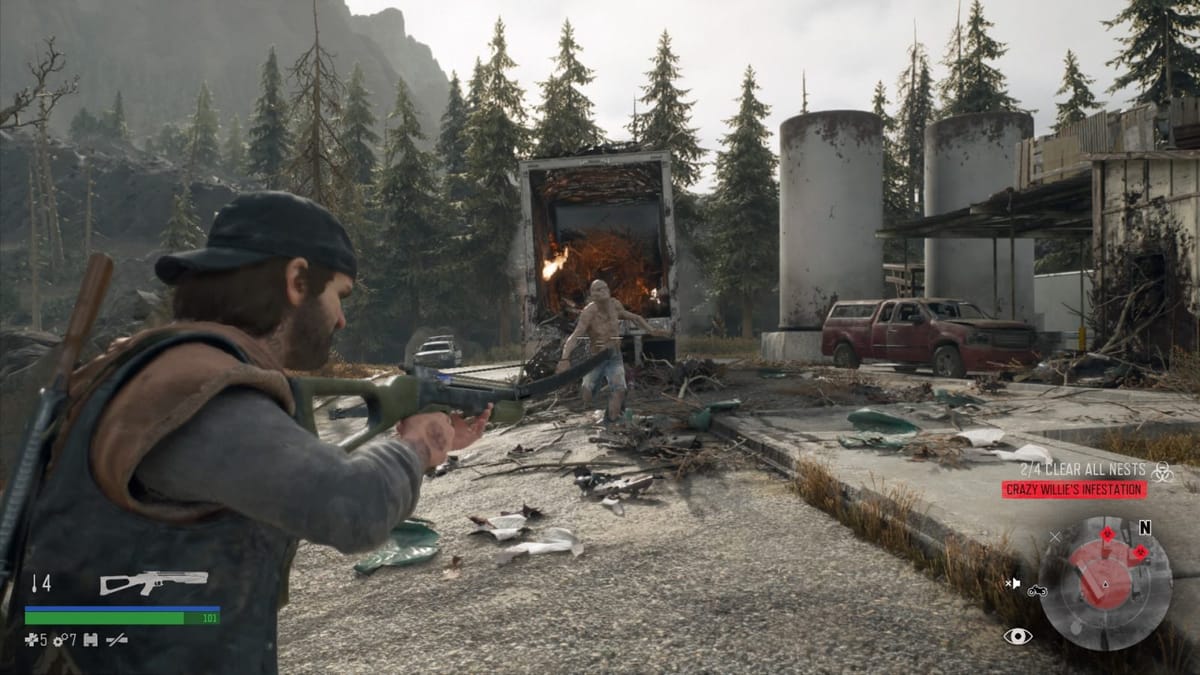
Though I didn’t know it at the time, the opening hour of Days Gone is a surprisingly thorough preview of how the rest of the game is going to go. You’re thrown without context into a complex web of post-apocalyptic survivors struggling against each other, then get brief glimpses of motorcycle rides with gorgeous environments, awkward melee combat, plentiful quick time events, uneven gunplay, and tense stealth, all punctuated by interminable cutscenes of unlikeable characters talking to each other and endless scrounging for junk to craft supplies from. Both these opening moments and the game to follow move along at a quick pace, bouncing from one activity to another, which kept me from getting bored, though there were times when I just wanted to be done with it.
Days Gone is an open world survival action game set after a zombie outbreak. If you’re familiar with the tropes that usually go along with all of those descriptors, you pretty much how know two thirds of the game plays out. Playing as sentient Ed Hardy t-shirt Deacon St. John, you’ll travel between camps of survivors, delivering supplies and protecting them from threats, while exploring the world at your own pace, gathering materials in the wild to craft weapons and healing items. At the camps you’ll meet with the kinds of eccentrics and dirtbags who always seem to be the most fit to survive the apocalypse; outside their walls, the people you meet might as well just be zombies with guns.
I’ve said zombies, but I guess I should be saying Freakers or Freaks — the terms that Days Gone uses for it enemies, despite sounding like a vague slur used by your grandpa when he’s been drinking, because apparently all the good names for zombies were already taken. Even the top-secret government scientists studying the infection call them Freaks, which is hilariously juxtaposed with the medical jargon they use to describe them. To get technical, Freakers are infected, rather than undead, more akin to the 28 Days Later-style fast zombies than the shambling hordes of Night of the Living Dead. Your primary threat during the early game is the Freakers wandering through the wilderness, mostly just shuffling around on their own to feed, but occasionally grouping up into roving swarms. As you make your way on foot through the woods during early missions, you’ll have to either sneak past or stealthily dispatch the few Freakers you come across.
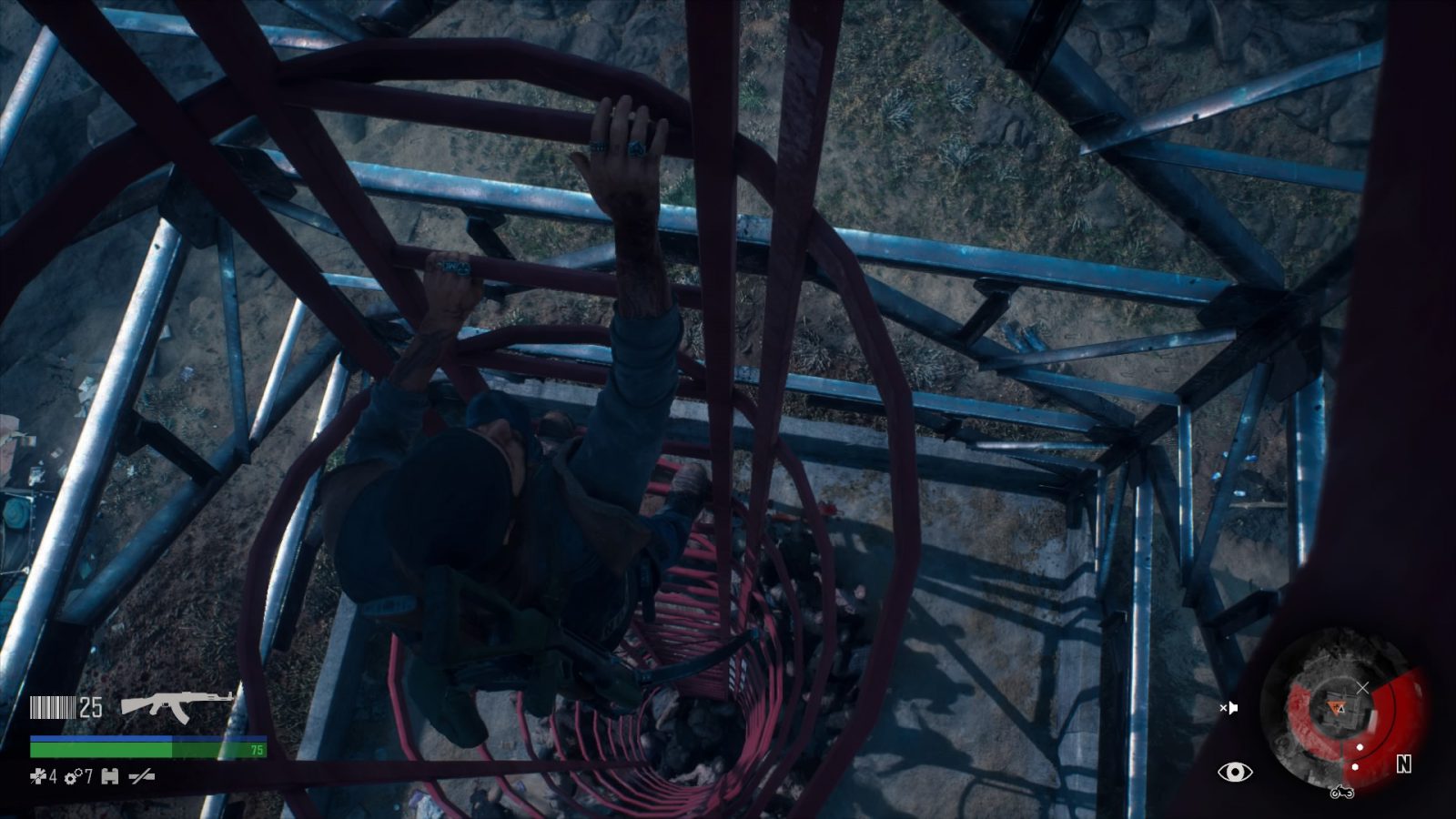
In the early game at least, trying to outmaneuver the Freakers is genuinely tense and frightening. They can come from anywhere, and once one spots you, its cries will alert others nearby. If you use an unsuppressed firearm to deal with them, you’ll just end up bringing more attention to yourself from further away. You’ll have to use cover well, attack from stealth when possible, and try to lure Freakers away from each other before attacking to prevent being overwhelmed. Once you get your motorcycle, things change quite a bit, but every time you have to explore an area on foot, the tension immediately gets ramped up again as you have to mind your surroundings and always have an escape route planned for when you draw more heat than you’re ready to deal with. One of the most consistently enjoyable parts of the game for me was finding the right balance between stealth and aggression in these sequences, judging which Freakers I could kill without alerting the rest to safely make it through an area.
As with basically any zombie story, the brainless hordes are only half of the problem. Along with Freakers roaming the wilderness, you’ll also frequently square off against other survivors. Most of these are described as marauders or squatters, and they’re either found in “ambush camps” or just moving around the world. You also have Rippers, an entirely nonsensical cult devoted to worshipping the Freakers, because post-apocalyptic stories always need self-mutilating death cults, I guess. You’ll also encounter some more powerful human enemies later in the game, but these two groups make up 99% of the people you’ll meet on the road, and they’re functionally identical. They charge you with clubs or shoot at you, and you take them down as Deacon revels in bloodshed, screaming with unnerving glee that they’re rapists and murderers.
Fighting against these human opponents was almost universally less satisfying than taking on the Freakers. Infiltrating camps and stealthily taking out guards is fun, but the farther into the game you get, the more combat against other people turns into boring long- to medium-range fights on battlefields conveniently strewn with cover. There are certainly times when you can get into the flow of battle, diving to cover, using your time-slowing Focus power to line up shots, crafting and throwing molotov cocktails at just the right moment, and it’s a lot of fun. But for the most part, Days Gone’s gunplay just feels like a mediocre cover shooter. It’s not terrible; it just doesn’t do anything novel or spectacular. It doesn’t have any particularly interesting weapons, and none of them felt satisfying to use, with the possible exception of some high-level shotguns. I loved the crossbow and used it more than any other weapon, but that was really just for its stopping power, not because it was more fun to use than any other weapon. The crossbow is also one of the weapons hit hardest by maybe my biggest problem with the gunplay: its nearly invisible crosshairs. Most weapons’ crosshairs are thin white or black lines that completely disappear into the background.
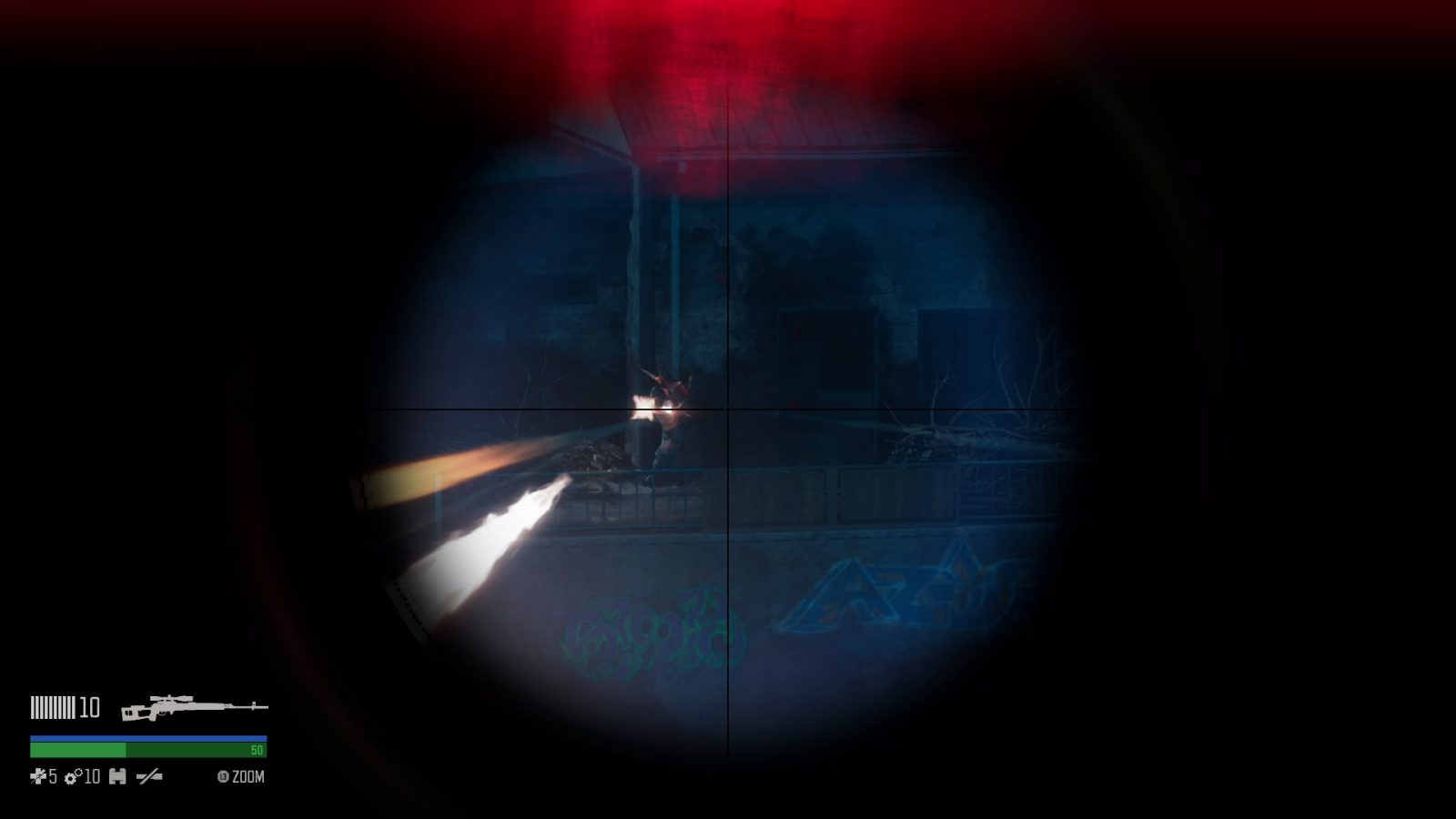
Melee combat is no better. You have one attack button, which you can just hammer away at when you’re in range of an enemy to keep swinging. At random intervals, your opponent will dodge, at which point you have to roll away before attacking again or they’ll counter attack. It feels extremely clunky and unsatisfying, with slow attack animations. Once in a while, an enemy will grab you and you’ll have to hammer away on one of the controller’s face buttons. A small, faint icon of which button you need to hit will appear somewhere onscreen, and a good 25% of the time, I couldn’t even find the icon before I died. There’s also no way to change these quick time events from requiring repeated button presses to holding the button, making them an accessibility nightmare for both people with limited vision and hand impairments.
When you kill an armed enemy, you can pick up their weapon and use it. Melee weapons degrade quickly, so you’ll have to constantly keep an eye out for those, and at first I was excited about the same thing happening with guns. In my first gun battle, I would kill an enemy, then pick up their weapon — a shotgun or assault rifle — and use the few shots left in it to kill the next enemy, then take their gun and use it on the next one. Ammo was scarce, so I kept switching between the weapons I picked up, resorting to melee when I needed to. That was essentially the last time a battle felt like that. Immediately afterward, I found enough ammo to keep my new assault rifle stocked up and almost never ran out of ammo again. I held onto the weapon that I picked up in that battle for more than a dozen hours afterward.
Of course, Days Gone’s biggest selling point isn’t the combat; it’s getting to ride through the woods popping wheelies and taking down zombies from your sick bike. Well, that particular fantasy doesn’t really come to pass, but the motorcycle is still probably the most interesting thing about this game. Obviously having a motorcycle makes exploring the open world more fun than just hoofing it all the way, but it’s much more important than that. On top of letting you reach far-flung places and escape stampeding Freakers, your motorcycle can hold spare ammo, and you need to be near it to fast travel or even save. That turns it into a sort of mobile command center, and getting too far from it will put you at a severe disadvantage. With all that power comes responsibility, though, and you’ll need to make sure you keep it fueled up and in good repair or you may end up without it when you need it most. I was intrigued by the possibilities of the system, especially needing to stop for gas in dangerous areas to keep moving, but in practice, it just turns into a minor form of friction. Since you can fast travel to camps and other points of interest, all you need to do is make small hops between fast travel points near gas stations, rather than really taking to the open road and collecting gas on the way.
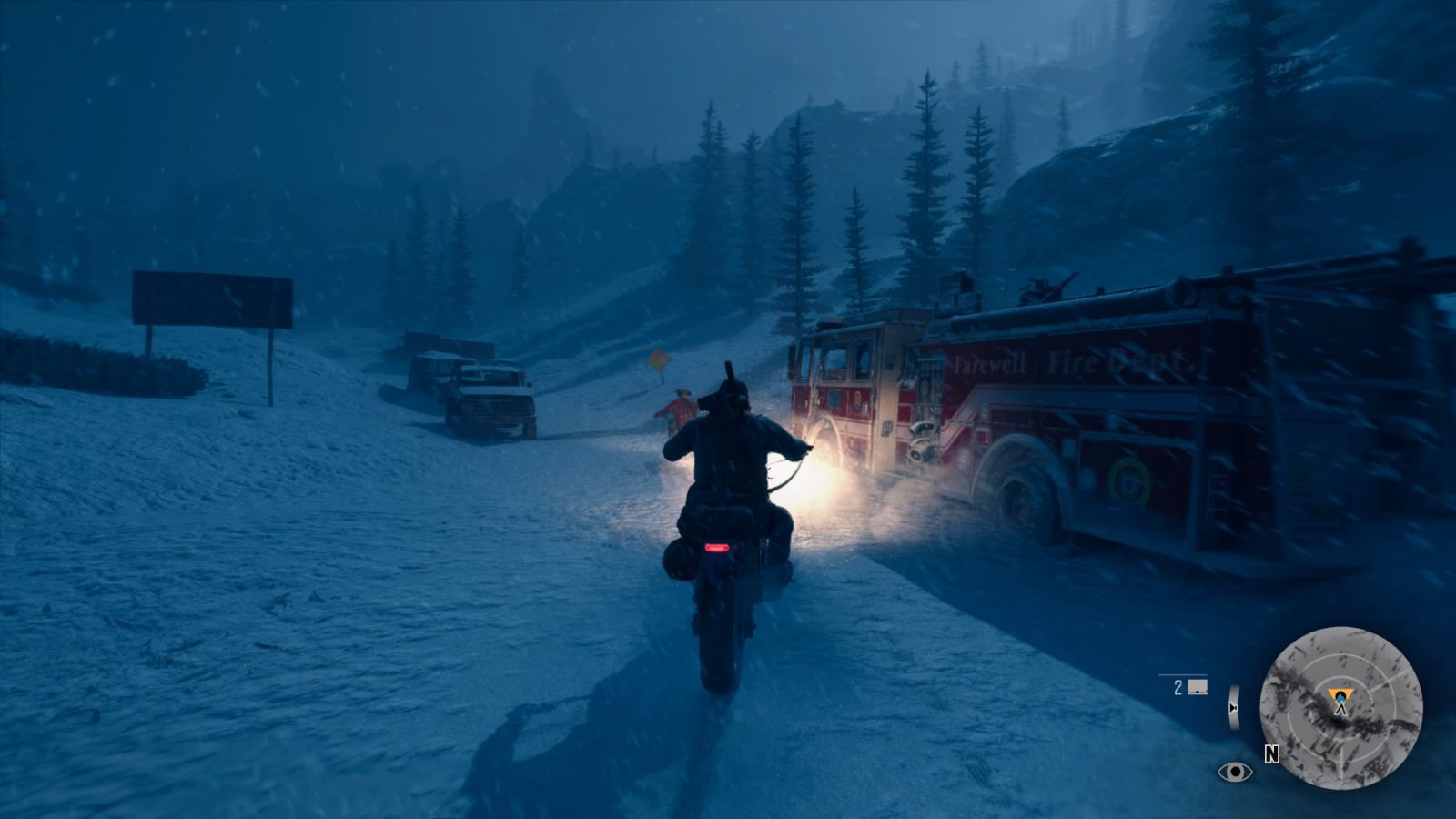
Riding your motorcycle may not be quite as satisfying as I’d hoped, but it’s still a lot of fun. I wanted to feel more weight from the motorcycle, more of a sensation of the tires flinging up dirt and bouncing over rocks. Still, tearing through the woods and along old mountain trails feels empowering and a little dangerous, and crashing into jaywalking Freakers is maybe the one thing in the game that never got any less fun no matter how many times I did it. Having your motorcycle nearby also gives you a way to escape quickly when hordes of Freakers begin to descend on you. At the same time, revving your engine will draw more down on your position, so you have to find a balance between getting out quickly and easing off the gas to keep new enemies from joining the chase. It may sound strange, but some of the most fun I had on the motorcycle wasn’t running at top speed from the Freaker hordes; it was slowly giving the bike just a little bit of gas, aiming for slopes so I could quietly coast downhill and away from danger before hitting the throttle when the road was clear.
On the other hand, motorcycle combat was a letdown. During certain missions, you’re tasked with chasing down people on their own bikes, and at any time, you can attack enemies from your ride, but neither option is that exciting. To fire your sidearm, you just press one button to lock on to the nearest target and your crosshair slowly narrows over time as your accuracy increases. When you like your chances, you just press another button to fire. And that’s it. There’s no way to aim for a specific part of your target, and while enemies can throw can toss molotovs from their bikes, you have no such option. That’s especially disappointing, because it prevents you from using your motorcycle when facing the other unique part of Days Gone: Freaker hordes.
Normally when you encounter Freakers, they’re wandering alone or in small clusters of a dozen or so, and taking them out is a pretty simple affair. Hordes are another matter entirely, comprising hundreds of Freakers all packed into the same area. Taking them out requires careful preparation and a much longer battle of hit and run tactics. What it takes more than anything is a lot of running and a full backpack. Firearms alone aren’t enough to take out a horde; you’ll need to stock up on explosives and healing items, plus bring enough materials to create more throughout the battle. The horde will climb over and around anything in its way to get to you, so to take one down, you need to find a way to funnel all the Freakers into a tight space, then thin their numbers with molotovs and bombs. You’ll face them in areas of the map like mass graves and overrun towns, which are strewn with cars, industrial equipment, and gas tanks that you can use to your advantage. Horde fights are exciting set pieces really unlike anything I’ve seen in any other game, but I usually found them more frustrating than enjoyable. For one thing, they don’t come up until the very end of the game, at which point I wasn’t too inclined to put in the time to track down and prepare for them. I had expected to run across them throughout the world, making them long-term antagonists to build up to, rather than suddenly blocking progress through the game near its conclusion. Once you’re in the fight, it turns into a resource sink more than anything. Freakers can run about as fast as you at top speed, so once you alert them, you need to keep running. Doing so burns through your stamina, though, so you need to keep it topped off with items called stamina cocktails. More than any weapon, these are the key to taking down a horde. If you run out, you pretty much don’t stand a chance.

The bigger a horde is, the more it starts to feel like a chore. For the largest one I fought, I had to break the encounter into several attempts, killing as many Freakers as I could with my supplies, then spending more time than I did fighting the horde traveling around the map to restock. After a while, these large hordes stopped being scary at all; they just became endurance tests. Still, the mid-sized hordes are fun encounters that force you to make the most of both your limited equipment and your environment to survive, and it’s hard to discount the thrill of outmaneuvering and defeating a small town’s worth of Freakers at once.
Horde fights also exacerbated some nagging control issues I’d been having throughout the game. When selecting a weapon from one category (say, throwables or crossbow bolts), the game would sometimes equip a different weapon from that same category than the one I’d chosen. Even opening the weapon wheel to select one sometimes simply wouldn’t work, leaving me repeatedly pressing the button to get it to come up so I could switch weapons.
Surprisingly, horde encounters ran well, even on my non-Pro PS4. I didn’t notice any wild slowdown in these fights, though there were plenty of other, seemingly less strenuous, areas where my frame rate slowed to a crawl. Other technical issues popped up frequently as well. Animations were buggy across the board, with characters sometimes sliding across the ground or getting locked into bizarre animation cycles, which could make them hard to hit in combat when it was an enemy doing it. A few times, there were even more bizarre accidents, like enemies launching straight up into the air or spontaneously running off into the distance. At one point, a couple of enemies started firing at the ground near me as I hid undiscovered in some foliage, then returned to their regular patrol as if nothing had happened. Audio bugs were also common, with characters sometimes seeming to trigger audio lines out of order or calling Deacon on his radio to have the same conversation multiple times in a row. In one instance, Deacon politely said hello to a marauder he’d snuck up on just before breaking his neck. I also suffered one hard crash and one infinite loading screen. Loading times in general are fairly monstrous on the standard PS4. It can take around four minutes to load up the game (yes, I timed it), and in-game load times can run one to two minutes.
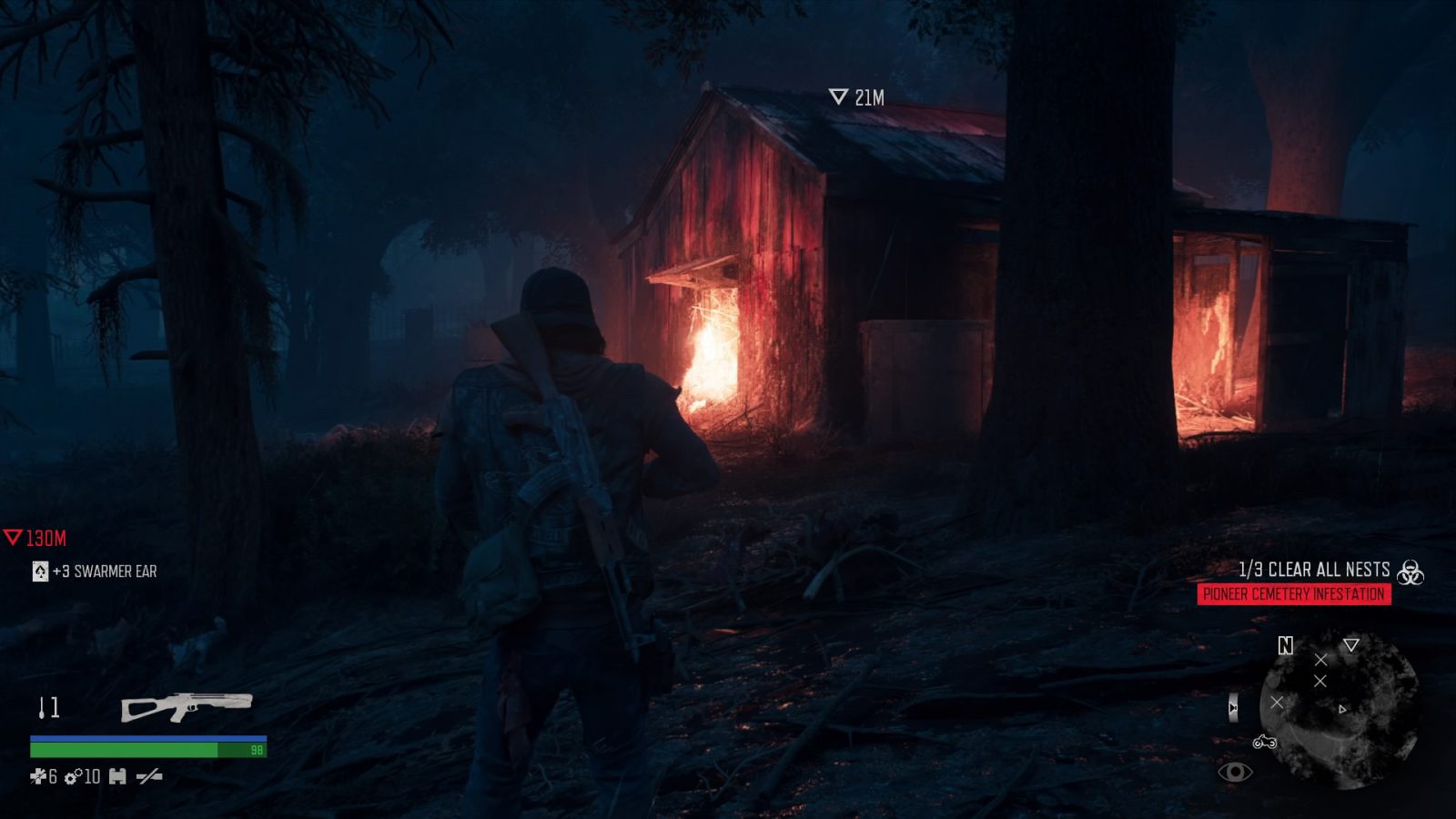
Even putting all of this aside, Days Gone has a lot of big-picture issues that sapped my enjoyment even when the moment-to-moment action was at its best. For the game’s first few hours, you’re running missions for two different camps, one run by a libertarian conspiracy theorist and the other operating essentially as a slave labor camp. Going on errands or sending lost survivors to a camp will earn you trust and credits. Higher trust unlocks new items for purchase with your credits, with each camp having different things for sale. These currencies count for each camp individually, which obviously makes narrative sense and also makes your choice of who to help important. Unfortunately, most of the missions you can do are extremely similar; the vast majority of them just consist of going to a camp to eliminate some baddies, or chasing someone down on your bike. As you’re doing these jobs, you’re also progressing through story missions, but it’s hard to tell how to keep the story moving. You’ll often have to do side missions to get story missions to trigger, and it seems to be based on the number you’ve done, rather than one leading to the next in any rational way. There were plenty of times that I turned a mission in to one character, drive halfway across the map, then had that same character call me on the radio to offer that mission’s follow-up. After you progress far enough in the story, you’ll unlock a third camp that has all the amenities of the first two and isn’t full of absolute shitheads, making all your progress gaining favor with the first two camps seem like a lot of wasted time. You can still do jobs and spend your camp credits there, but there’s no reason not to focus on the third camp at this point.
Still, for the first two-thirds of the game, this system works. After that, though, things go downhill. At that point, the game throws some intense, climactic missions at you, which wrap up most of its important narrative threads. But still it limps on, sending you to a new area disconnected from the rest of the game to do some missions having nothing to do with what you have been working toward the entire time. It makes everything you’ve been working for seem pointless up to that point. This is definitely a problem with more open world games than Days Gone, but it feels particularly bad in this game.
The story from here takes all kinds of detours, continually building up to resolution then knocking it down. It does the same thing with major plot points throughout the game, hyping up encounters and confrontations, then letting them fall flat. Throughout the game, Deacon and a few other key characters seem to act in ways designed to keep tension high, rather than behaving the way that any human being would. You would think that a game about bikers fighting zombies would have some kind of energy, but its story is dull and entirely self-serious. I was impressed by how much the story focuses on building relationships and establishing a new home, but that’s almost always done by killing people your quest givers don’t like, when there are so many other ways missions could have been built around providing aid to the camp.

But Deacon St. John isn’t equipped for anything but destruction. My favorite thing about him is the roughly 10,000 times that characters say Deacon St. John, a top-tier bad action hero name right up there with John Matrix. My least favorite thing about him is everything else. He goes out of his way to be unpleasant to almost everyone he meets, sneering with contempt at every other character. At one point, he’s asked why he thinks average people turned so violent after the outbreak, and he points to America’s atrociously high prison population as evidence that people were always bad — one of the most stunningly ignorant comments I’ve ever heard, especially coming from a character who admits to committing assault even before the outbreak. Moments that should have been cathartic or redeeming were completely undercut by his impulsive aggression and surliness. Despite being an obnoxious asshole, the game still wants you to care about him, so you get stunningly bizarre moments like a flashback that only exists for Deacon to point out that he isn’t a racist, because he did, in fact, have a black friend once, and constant mentions of his moral “code” of not murdering unarmed women. What a guy. It’s not like a better protagonist would have made Days Gone a great game, but it would have kept me more invested if I were playing as someone who was at least trying to do better.
Days Gone
All Right
Days Gone features some potentially interesting community-building mechanics and the appeal of a bikers vs. zombies game is hard to ignore, but it never lets its best ideas take center stage. Instead, it focuses on lackluster combat and a repetitive set of missions. It moves along on the kind of momentum that exists almost by default in big open world packed with activities, but I could never get fully engaged, partly due to its dragging pace, scattershot story, off-putting protagonist, and frequent bugs.
Pros
- Outrunning hordes on your motorcycle is fun
- Camp trust and credits are interesting, if underdeveloped, concepts
Cons
- Lackluster combat
- Strange mission structure and repetitive side quests destroy the game’s pace
- Riddled with minor bugs and a few major ones
